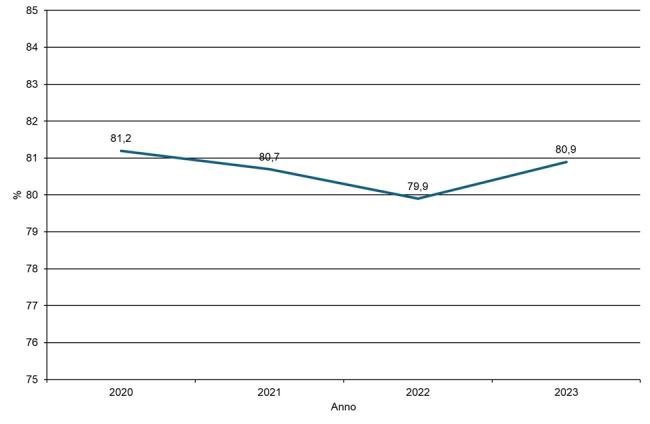Panel 1
Angelo Santini, Fabio Tatti
In 2023, the ratio between the amount of organic waste recycled and the amount separately collected reached 80.9%, showing an increase compared to both 2022 (79.9%) and 2021 (80.7%).
Organic waste constitutes a key stream for achieving the municipal waste recovery and recycling targets set by current legislation. It is therefore essential, on the one hand, to capture increasing quantities through more efficient separate collection systems, with the aim of minimizing the amount sent to landfill. The indicator measures the ratio between the annual quantity of organic waste collected separately and the quantity effectively recycled, and is included in the core set of indicators identified by the National Strategy for the Circular Economy.
Measuring progress in circularity policy thus enables the establishment of a foundation for identifying common long-term objectives and for defining new policy measures.
For the organic waste fraction, the separate collection obligation has been in force at the European Union level since 31 December 2023 (Article 22 of Directive 2008/98/EC). In Italy, pursuant to Article 182-ter of Legislative Decree No. 152/2006, the obligation has been in force for all municipalities since 31 December 2021.
According to paragraph 6 of the aforementioned Article 182-ter, the collection of the organic fraction also includes biodegradable and compostable packaging and materials, certified according to UNI EN 13432.
The legislation on the collection of organic waste and biodegradable and compostable plastics is of particular importance as it:
- significantly contributes to achieving the national target of at least 65% separate collection of municipal waste;
- plays a key role in meeting the European municipal waste recycling targets (50% by 2020, 55% by 2025).
Panel 2
ISPRA - Rapporto Rifiuti Urbani (various editions)
Data quality assessment
ISPRA (Italian Institute for Environmental Protection and Research)
Collection data at the national level, by regional macro-area, region, province, and municipality are freely accessible and downloadable from the website www.catasto-rifiuti.isprambiente.it.
National
2020-2023
Indicator assessment
The indicator is calculated by relating the total amount of recycled organic waste to the total amount of organic waste collected in Italy.
In 2023, the ratio between the amount of organic waste recycled and the amount separately collected was 80.9% (Table 1 and Figure 1).
The trend since 2020 has remained essentially stable. In 2023, the percentage value was 80.9%, showing a slight increase compared to 79.9% in 2022 and 80.7% in 2021 (Table 1 and Figure 1).
Data
Trend in the ratio between quantities of recycled organic waste and separately collected quantities, years 2020–2023
ISPRA

A comparison between the overall municipal waste separate collection rate (66.6% in 2023) and the recycling rate (50.8%) reveals a non-negligible gap between collection and material recovery. This underscores the need to focus particularly on the quality of collection, which is especially critical for organic waste. High-quality collection is essential to ensure the production of compost that meets regulatory standards and can therefore be marketed as a product (Table 1).
Moreover, organic waste sent for recycling represents the most influential waste stream in determining the municipal waste recycling rate, accounting for 41% of the total.